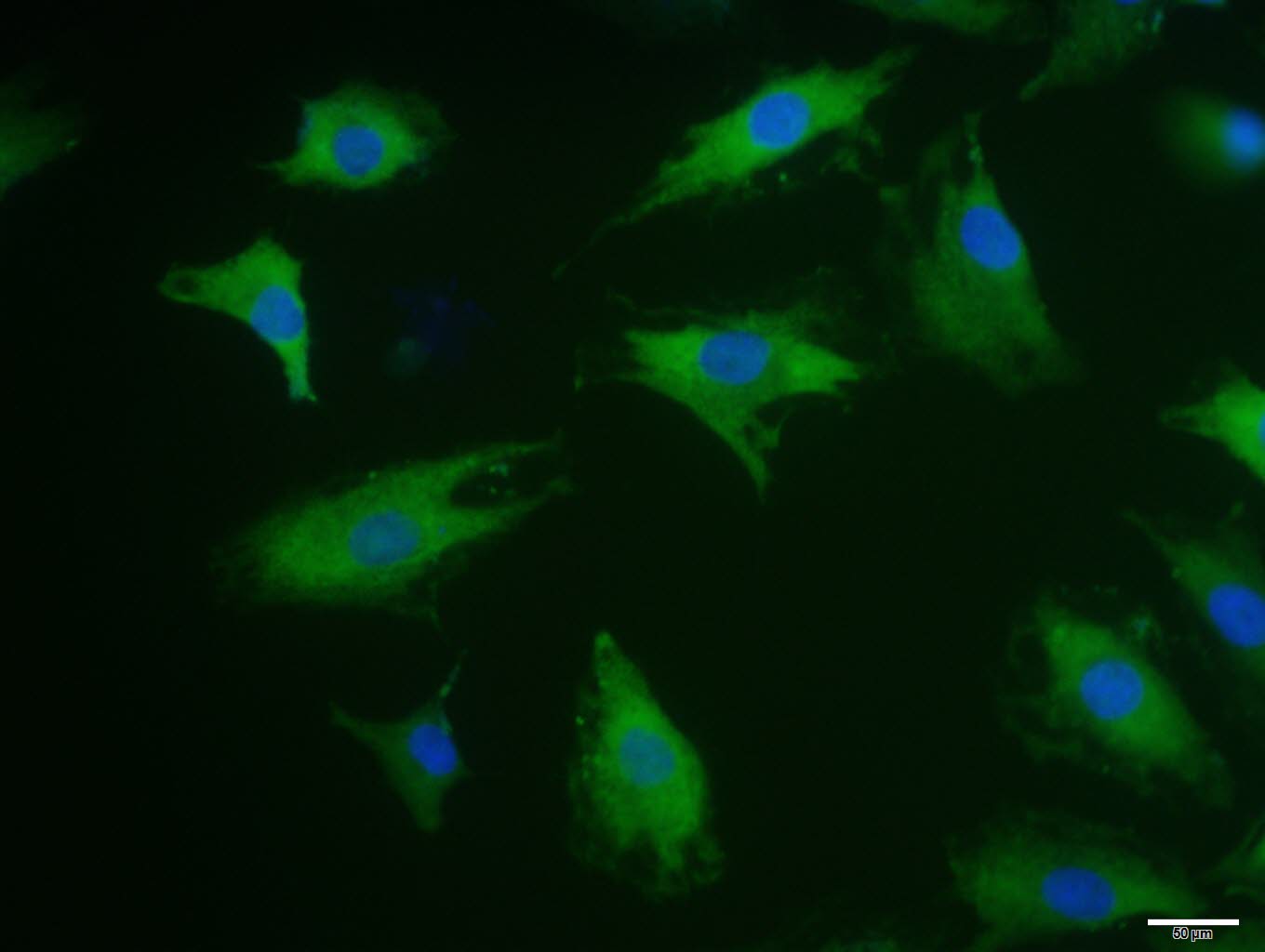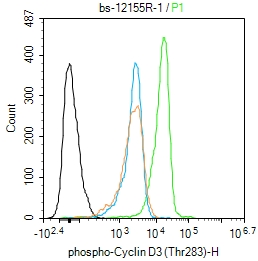
Rabbit Anti-phospho-Cyclin D3 (Thr283)antibody
Cyclin D3 (phospho T283); Cyclin D3 (phospho Thr283); p-Cyclin D3 (T283); p-Cyclin D3 (Thr283); p-Cyclin D3 (phospho T283); CCND 3; Ccnd3; CCND3_HUMAN; CyclinD3; D3 type cyclin; G1 S specific cyclin D3; G1/S specific cyclin D3; G1/S-specific cyclin-D3.
View History [Clear]
Details
Product Name phospho-Cyclin D3 (Thr283) Chinese Name 磷酸化周期素D3抗体 Alias Cyclin D3 (phospho T283); Cyclin D3 (phospho Thr283); p-Cyclin D3 (T283); p-Cyclin D3 (Thr283); p-Cyclin D3 (phospho T283); CCND 3; Ccnd3; CCND3_HUMAN; CyclinD3; D3 type cyclin; G1 S specific cyclin D3; G1/S specific cyclin D3; G1/S-specific cyclin-D3. Product Type Phosphorylated anti Research Area Tumour Cell biology Chromatin and nuclear signals Cyclin Epigenetics Immunogen Species Rabbit Clonality Polyclonal React Species Human, (predicted: Mouse, Rat, Chicken, Dog, Pig, Cow, Horse, Rabbit, Sheep, ) Applications ELISA=1:5000-10000 Flow-Cyt=1ug/Test ICC=1:100
not yet tested in other applications.
optimal dilutions/concentrations should be determined by the end user.Theoretical molecular weight 33kDa Cellular localization The nucleus cytoplasmic The cell membrane Form Liquid Concentration 1mg/ml immunogen KLH conjugated synthesised phosphopeptide derived from human Cyclin D3 around the phosphorylation site of Thr283: TS(p-T)PT Lsotype IgG Purification affinity purified by Protein A Buffer Solution 0.01M TBS(pH7.4) with 1% BSA, 0.03% Proclin300 and 50% Glycerol. Storage Shipped at 4℃. Store at -20 °C for one year. Avoid repeated freeze/thaw cycles. Attention This product as supplied is intended for research use only, not for use in human, therapeutic or diagnostic applications. PubMed PubMed Product Detail The protein encoded by this gene belongs to the highly conserved cyclin family, whose members are characterized by a dramatic periodicity in protein abundance through the cell cycle. Cyclins function as regulators of CDK kinases. Different cyclins exhibit distinct expression and degradation patterns which contribute to the temporal coordination of each mitotic event. This cyclin forms a complex with and functions as a regulatory subunit of CDK4 or CDK6, whose activtiy is required for cell cycle G1/S transition. This protein has been shown to interact with and be involved in the phosphorylation of tumor suppressor protein Rb. The CDK4 activity associated with this cyclin was reported to be necessary for cell cycle progression through G2 phase into mitosis after UV radiation. Several transcript variants encoding different isoforms have been found for this gene. [provided by RefSeq, Oct 2008].
Function:
Regulatory component of the cyclin D3-CDK4 (DC) complex that phosphorylates and inhibits members of the retinoblastoma (RB) protein family including RB1 and regulates the cell-cycle during G(1)/S transition. Phosphorylation of RB1 allows dissociation of the transcription factor E2F from the RB/E2F complex and the subsequent transcription of E2F target genes which are responsible for the progression through the G(1) phase. Hypophosphorylates RB1 in early G(1) phase. Cyclin D-CDK4 complexes are major integrators of various mitogenenic and antimitogenic signals. Also substrate for SMAD3, phosphorylating SMAD3 in a cell-cycle-dependent manner and repressing its transcriptional activity. Component of the ternary complex, cyclin D3/CDK4/CDKN1B, required for nuclear translocation and activity of the cyclin D-CDK4 complex.
Subunit:
Interacts with the CDK4 and CDK6 protein kinases to form a serine/threonine kinase holoenzyme complex. The cyclin subunit imparts substrate specificity to the complex. Interacts with ATF5. Interacts with EIF3K. Component of the ternary complex cyclin D/CDK4/CDKN1B required for nuclear translocation and modulation of CDK4-mediated kinase activity. Can form similar complexes with either CDKN1A or CDKN2A.
Subcellular Location:
Nucleus. Cytoplasm. Membrane. Note=Cyclin D-CDK4 complexes accumulate at the nuclear membrane and are then translocated to the nucleus through interaction with KIP/CIP family members.
Tissue Specificity:
Post-translational modifications:
Polyubiquitinated by the SCF(FBXL2) complex, leading to proteasomal degradation.
Similarity:
Belongs to the cyclin family. Cyclin D subfamily.
Contains 1 cyclin N-terminal domain.
SWISS:
P30281
Gene ID:
896
Database links:
Entrez Gene: 896 Human
Entrez Gene: 12445 Mouse
Omim: 123834 Human
SwissProt: P30281 Human
SwissProt: P30282 Mouse
Unigene: 534307 Human
Unigene: 27291 Mouse
Unigene: 472101 Mouse
Unigene: 3483 Rat
Unigene: 54319 Rat
Product Picture
Primary Antibody (green line): Rabbit Anti-phospho-Cyclin D3 (Thr283) antibody (SL12155R)
Dilution:1ug/Test;
Secondary Antibody(white blue line): Goat anti-rabbit IgG-AF488
Dilution: 0.5ug/Test.
Isotype control(orange line): Normal Rabbit IgG
Protocol
The cells were fixed with 4% PFA (10min at room temperature)and then permeabilized with 90% ice-cold methanol for 20 min at -20℃, The cells were then incubated in 5%BSA to block non-specific protein-protein interactions for 30 min at room temperature .Cells stained with Primary Antibody for 30 min at room temperature. The secondary antibody used for 40 min at room temperature. Acquisition of 20,000 events was performed.
Bought notes(bought amounts latest0)
No one bought this product
User Comment(Total0User Comment Num)
- No comment




 +86 571 56623320
+86 571 56623320
 +86 18668110335
+86 18668110335

